
Come into the exhibition Iqqaipaa: Celebrating Inuit Art,
1948-1970 at the Canadian Museum of Civilization and explore both the
Multimedia Resource Centre and the Interactive Area to learn more about Canada's
Inuit and the works of art featured in this exhibition. Here are two highlights
from the Interactive Area that explore Inuit art making.
Inuit Art : A Further Exploration
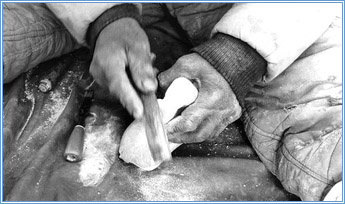
Lucassie Tookalak Carving, 1985
Photographer: Cheryl Lean.
For today's Inuit, art provides a source of income as well as a
means of cultural expression. In their works, artists document traditional ways,
raise important social issues, and depict stories and legends. Explore the displays
in this section to learn more about the traditional way of life of the Inuit, as
represented in works of art, and the techniques used by Inuit artists to produce
sculptures and prints.
Inuit Sculpture
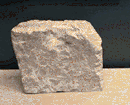 Inuit artists use basically the same tools as other artists. From 1948 to 1970, sculptors used mainly pocket knives, files and hand-made tools adapted to their personal needs. Inuit artists use basically the same tools as other artists. From 1948 to 1970, sculptors used mainly pocket knives, files and hand-made tools adapted to their personal needs.
The technique used to produce a sculpture depends on the material
- whalebone, ivory, antler or stone - and its characteristics. In this display,
Henry Kudluk, a contemporary artist, has employed techniques used by artists from
1948 to 1970 to illustrate the five stages in the production of a sculpture of a bear.
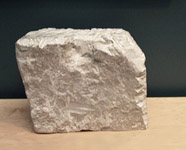 1. Selection of the stone 1. Selection of the stone
Quarrying stone for sculptures can be a laborious task.
Artists often have to travel far from their communities by snowmobile,
komatik (sled) or boat. The stone itself has little commercial
value; the cost of fuel for the trip to the quarry represents the main
expense incurred by artists.
 2. Initial shaping of the stone 2. Initial shaping of the stone
Inuit sculptors import most of their tools from southern
Canada or other countries. In the past, they roughed out the stone using
axes of various sizes. Today, they usually use power tools.
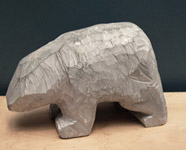 3. Adding detail 3. Adding detail
After the initial shaping of the stone, the sculpture is
further defined using chisels, often without a hammer. As the work becomes
more detailed, artists use an assortment of files to perfect the shape of the
piece. Once completed, the sculpture is usually washed in a tub of water to
remove dust and stone fragments.
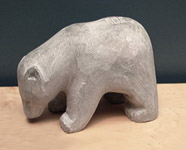 4. Polishing 4. Polishing
If the artist is satisfied with the sculpture, the
polishing begins. Wet-or-dry paper (carborundum paper) does not dissolve
in water, so it is ideal for smoothing stone carvings under water. Water
acts as a lubricant. Using the finest grade of paper, artists can obtain a
very smooth and unblemished surface on most types of stone.
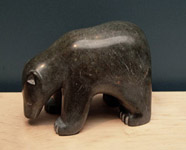 5. Final touches 5. Final touches
Sculptures that are polished in water using wet-or-dry
paper need only be buffed with a dry cloth. Artists in Nunavik often use
shoe polish to give their grey stone a more interesting colour.
Highly polished sculptures have usually been covered with a layer of
beeswax, which used to be applied by heating the stone with a blowtorch.
Today, microwave ovens are used to heat stone evenly.
Photographer: Harry Foster, Canadian Museum of Civilization.
Inuit Prints
From 1948 to 1970, stonecut and stencilling were the main
techniques used to make prints in the Canadian Arctic. Other techniques
have been added since then, including lithography, engraving, silk-screening,
etching and aquatint. Stonecut and stencilling remain important, however, and
are often combined.
Stonecut
The stonecut technique is an adaptation of the woodcut, with
stone replacing wood as a printing surface. The image to be printed is carved in
relief on the printing block.
When making a stonecut, the printer usually traces a drawing
by an artist on a stone slab that has been painted white. The image is then
retraced with India ink, and the areas that are not to be printed are chiselled
away. Using a soft rubber roller, the printer inks the image, starting with light
shades then adding the darker ones in layers.
-
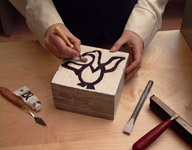 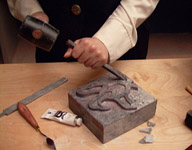 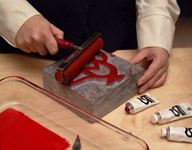
-
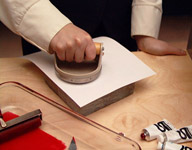
The inking process may take an hour or more and must be repeated
for each print in the edition. Once the inking is completed, a protective cover
resembling a stencil is placed over the block to mask areas that are not to be
printed. The image is now ready to be printed on paper.

Only soft rice paper, such as mulberry paper, is absorbent
enough for a stonecut. The paper is placed over the inked image and rubbed against
it with varying pressure. The print is then peeled off and hung to dry.
Photographer: Harry Foster, Canadian Museum of Civilization.
Iqqaipaa Menu
|